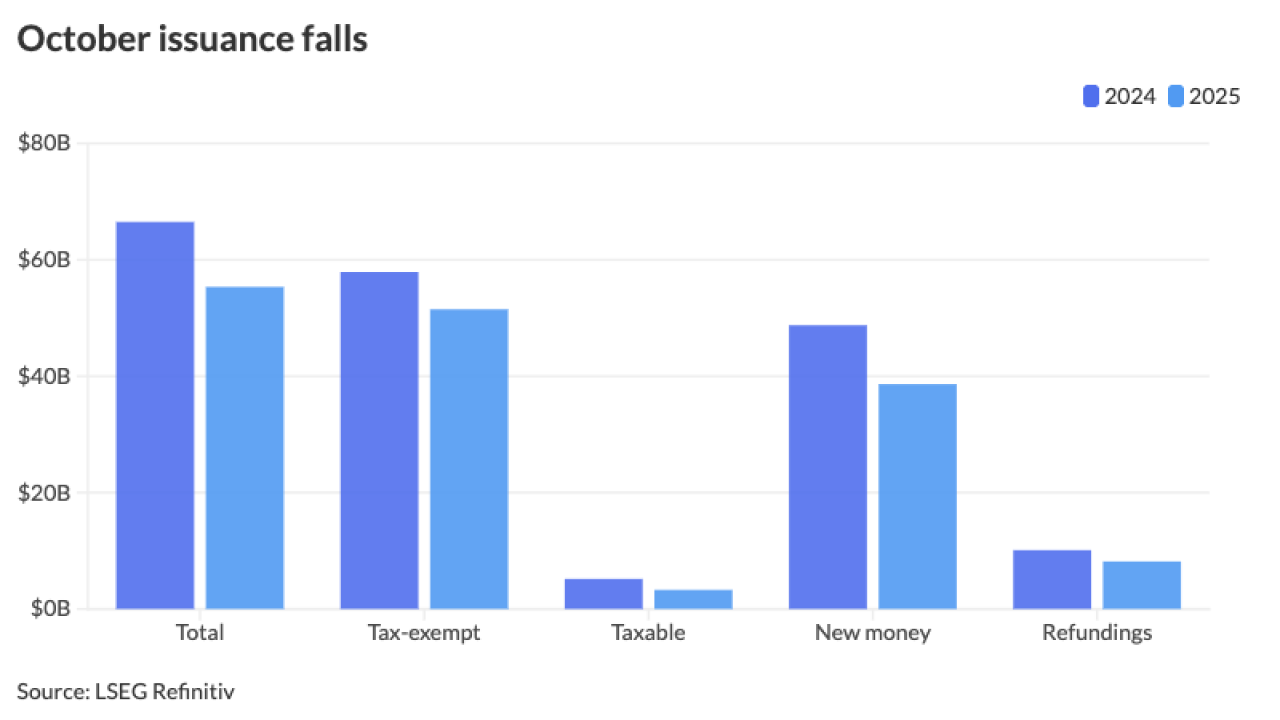The municipal bond market received a variety of data Thursday suggesting economic strength belying the recession forecast by the 2/10-year Treasury yield curve inversion on Wednesday.
Consumers continue to power economic growth, as retail sales rose 0.7% in July, after a 0.3% increase in June, the Commerce Department reported Thursday. Excluding autos, sales soared 1.0%, after a 0.7% climb in June.
Economists polled by IFR Markets expected a 0.3% rise in the headline number and 0.4% excluding autos.
Auto sales were down 0.6% in July, after 0.3% growth the prior month.

“The resilience of the U.S. economy has been remarkable and somewhat surprising,” according to Mark Hamrick, senior economic analyst at Bankrate.com. One reason for the “much stronger-than-expected retail sales data was a spike in online sales resulting from Amazon Prime Day."
“The details of this report clearly indicate that strong spending momentum is carrying into H2,” Berenberg Capital Markets Chief Economist U.S., Americas and Asia Mickey Levy and U.S. Economist Roiana Reid wrote in a note.
“The strong retail sales are consistent with our forecast that solid growth in consumption (including services) will more than offset the U.S. and global industrial slump and declining exports, and support moderately healthy economic growth,” they wrote. “As long as consumer confidence remains elevated, we remain comfortable with this expectation, even though mounting uncertainties about the dampening impacts of trade policy tensions and the global industrial slump as well as the associated heightened financial market volatility pose serious risks.”
However, this report may not change the Federal Reserve's thinking. “A solid July retail sales report does nothing to either arrest mounting concerns of a global slowdown amid growing international uncertainties and risks or undermine the need for the Fed to offer additional accommodation," said Stifel Chief Economist Lindsey Piegza.
Not all is well with retail, and “consumers aren’t going to ride to the rescue and take an abundance of clothing inventory off the hands of brick-and-mortar retailers, certainly not at full price,” Bankrate’s Hamrick added. “The sorting out of winners and losers in this space is accelerating.”
A
Productivity
Preliminary second quarter productivity figures also were positive news for the economy, as non-farm productivity grew a healthy 2.3% on an annualized basis in the second quarter, albeit down from the first quarter’s 3.5% growth, the Labor Department reported. Unit labor costs grew 2.4% in the period, after a revised 5.5% jump in the first quarter, previously reported as a 1.6% decline.
Economists projected a 1.5% gain in productivity and a 1.8% rise in labor costs.
“Real, inflation-adjusted compensation is rising at a healthy pace and businesses have lifted productivity, constraining operating costs, which is allowing them to maintain margins,” Levy and Reid wrote in a separate note. “These trends are important fundamentals underlying the durability of this economic expansion.”
The rise in productivity and labor costs “provides key support for consumer spending and the economy,” they wrote.
Manufacturing
The Empire State Manufacturing Survey suggested modest growth, as the general business conditions index crept to 4.8 in August from 4.3 in July. The new orders and shipments indexes also gained. The six-months ahead general business conditions index dropped to 25.7 from 30.8, the Federal Reserve Bank of New York reported.
Economists expected a 1.9 reading.
The Federal Reserve Bank of Philadelphia’s Report on Business general activity index fell to 16.8 in August from 21.8 in July. “The survey’s future activity indexes remained positive, suggesting continued optimism about growth for the next six months.”
Although this index declined, economists saw a bigger drop, to 10.0, since the survey was an outlier, hitting a 12-month high in July, while other similar surveys showed a struggling manufacturing sector.
The industrial production report from the Fed confirmed a slowdown in global manufacturing, as only 8 of the 23 categories gained in July, compared to the previous year. Industrial production dropped 0.2% in July, but the June number was revised up to a 0.2% from the previously reported flat level. Capacity utilization slid to 77.5 in July from 77.8.
Economists expected production to rise 0.1% and a 77.9 level for capacity use.
“To some degree undermining the positive story on the U.S. consumer is the weakness in manufacturing, which serves as a reminder that we’re still part of a globally interconnected economy,” Hamrick said. “This is the result of the headwinds, maybe we can call them trade winds, originating around the globe.”
Jobs
Initial jobless claims rose to 220,000 in the week ended Aug. 10 from 211,000 the prior week, while continuing claims rose to 1.726 million from 1.687 million.
Economists expected 212,000 claims in the week.
“While businesses have become more cautious generally in the face of rising uncertainty, hiring has remained firm,” Hamrick noted. “We’ve seen a rise in new claims for unemployment benefits, but not so much to be alarming.”
Business inventories
Business inventories were unchanged in June after a 0.3% rise in May, while sales grew 0.1% after a 0.1% decrease in May, the Commerce Department reported.
Economists expected a 0.1% rise in inventories.
Housing
Builders’ confidence in the market for new single-family homes grew as the National Association of Home Builders' housing market index rose to 66 in August from 65 in July. Economists expected a 65 reading.
“The housing market has failed to generate as much activity as some might have expected because of falling mortgage interest rates,” Hamrick noted. “The primary impact of that has been to energize mortgage refinancing. The continued rise in home prices, outpacing wage gains, has been one factor restraining home sales.”





